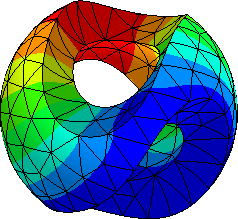10. The motion of fluids#
Philip Lederer and Christoph Lehrenfeld
10.1. The system of PDEs#
We consider the velocity \(u : \Omega \rightarrow {\mathbb R}^d\) and the pressure \(p : \Omega \rightarrow {\mathbb R}\) in an Eulerian setting (i.e. we do not follow specific “fluid-particles”), a given kinematic viscosity \(\nu: \Omega \rightarrow {\mathbb R}\) and a volume force \(u : \Omega \rightarrow {\mathbb R}^d \). The motion of an incompressible fluid on a domain \(\Omega \subset \mathbb{R}^d\) is given by the non-linear Navier-Stokes equations
which follow by Newton’s laws, i.e., the conservation of momentum and the conservation of mass, respectively. Here, \(\sigma: \Omega \rightarrow {\mathbb R}^{d \times d}\) is the stress tensor for which we have for a Newtonian fluid the relation
For a constant viscosity and using the identity
we have
Note
Note, that above simplification of the diffusive part of the stress tensor only holds if the solution is smooth or when considering certain boundary conditions.
10.2. Boundary and initial conditions#
The Navier-Stokes equations need to be accomplished by a suitable initial condition \(u^0 = u(x, t = 0)\) and boundary conditions. Let \(\partial \Omega = \Gamma = \Gamma_{wall} \cup \Gamma_{in} \cup \Gamma_{out}\), then we consider solid walls (no slip, homogeneous Dirichlet)
inflow boundary conditions (non homogenous Dirichlet)
and outflow (“do nothing” hom. Neumann, i.e. zero stress) conditions
Note, that on a non penetrable wall one might also consider slip boundary conditions \(u \cdot n = 0, u \cdot t = u_{slip}\) on a boundary \(\Gamma_{slip}\).
In the next units we will treat the followin aspects of solving the Navier-Stokes equations, where a large first block will treat the Stokes equations (where the time derivative and the convective term are neglected):
Conforming finite element discretizations for the Stokes equations
iterative (and parallel) solvers for Stokes
Normal-continuous Hybrid DG discretization (and solver) for Stokes
Tunings and tricks for Hybrid DG and normal-continuous Hybrid DG discretizations
Navier-Stokes solvers based on IMEX (implicit-explicit) time-stepping
